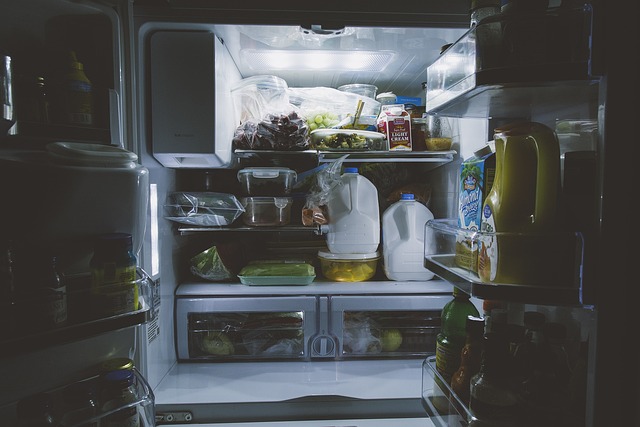When your refrigerator starts performing suboptimally due to poor cooling, it's essential to assess whether a repair or replacement of the compressor is necessary. A professional repair service should inspect the appliance for issues like circuit breaker trips or mechanical faults that can often be resolved through repair with regular maintenance. However, if the compressor is significantly damaged from wear and tear, advanced age, or trauma, a replacement might be the only viable option. Warning signs of such damage include high energy consumption, inability to reach desired temperatures, and irregular cycling patterns. A prompt professional assessment can accurately diagnose the problem and recommend whether repair or replacement is needed to restore the refrigerator's functionality and cooling efficiency. For repairable compressors, cleaning the condenser coils and recalibrating if necessary are important steps to enhance performance. After any repair, regular maintenance should be performed to ensure the longevity of the compressor. Always refer to your user manual for guidance on safe and effective refrigerator repair procedures, focusing on the compressor to resolve cooling issues efficiently. This guide provides a comprehensive approach to troubleshooting and repairing your refrigerator's compressor, ensuring it returns to optimal cooling performance.
When your refrigerator’s cooling efficiency wanes, addressing the issue promptly can prevent food spoilage and maintain a comfortable home environment. This article delves into the essentials of determining whether your refrigerator’s compressor requires repair or replacement to restore its optimal performance. We’ll guide you through a step-by-step process, ensuring your refrigerator repair is conducted with precision for lasting cooling efficiency. Refrigerator Repair expertise is key in this endeavor, enhancing your appliance’s longevity and efficacy without the need for premature replacement.
- Assessing the Need for Compressor Repair or Replacement in Your Refrigerator
- Step-by-Step Guide to Restoring Cooling Efficiency Through Compressor Repair and Replacement
Assessing the Need for Compressor Repair or Replacement in Your Refrigerator

When your refrigerator is underperforming and failing to maintain the desired cooling efficiency, assessing whether compressor repair or replacement is necessary involves a few critical steps. A malfunctioning compressor can lead to inadequate cooling, which may be remedied by repair if the issue is minor, such as a tripped circuit breaker or a simple mechanical fault. Regularly scheduled maintenance can help identify and resolve these issues promptly, ensuring your refrigerator operates efficiently. However, if the compressor is beyond repair due to significant wear and tear, advanced age, or substantial damage, replacement becomes the most viable option. It’s crucial to evaluate the compressor’s performance by checking for signs like unusually high energy consumption, prolonged failure to reach desired temperatures, or frequent cycling that doesn’t result in proper cooling. A professional refrigerator repair service can diagnose the problem accurately and recommend the best course of action, whether it’s a simple fix or a more involved compressor replacement. Acting swiftly upon noticing these symptoms can prevent further complications and restore your refrigerator’s cooling efficiency effectively.
Step-by-Step Guide to Restoring Cooling Efficiency Through Compressor Repair and Replacement

When your refrigerator’s cooling efficiency wanes, a thorough examination of the compressor is often necessary to diagnose and address the issue effectively. A step-by-step guide for refrigerator repair that focuses on the compressor can help restore your appliance’s cooling performance. The first step involves inspecting the compressor for any evident signs of damage or wear, such as cracks, bulging, or excessive soot buildup, which could indicate a malfunction or overheating. If the compressor is damaged beyond repair, replacing it with a compatible model is essential to ensure optimal cooling. Proper installation follows this, mandating careful attention to the electrical connections and mounting brackets as per the manufacturer’s guidelines.
Should the compressor be salvageable, the next steps include cleaning the condenser coils and ensuring that there are no obstructions hindering airflow. This maintenance task can significantly enhance the unit’s performance and cooling efficiency. If the compressor is operating but not effectively cooling the refrigerator, it may require recalibration or adjustment of its settings. This process involves checking the pressure and temperature readings against manufacturer specifications and making necessary adjustments to achieve the desired cooling levels. Regular maintenance after repair can further prolong the lifespan of your refrigerator’s compressor and maintain its cooling efficiency. Always refer to the user manual for safety precautions and detailed troubleshooting steps when performing refrigerator repair tasks.
Restoring cooling efficiency in your refrigerator can be achieved through diligent assessments and timely repairs or compressor replacements. The guide provided outlines the necessary steps to diagnose and address issues with your appliance’s compressor, ensuring it operates at peak performance. By understanding the signs that indicate when a repair or replacement is needed, homeowners can prevent further complications and maintain optimal cooling efficiency. Regular maintenance of your refrigerator’s compressor not only extends its lifespan but also ensures consistent food safety and energy savings. When facing compressor malfunctions, it’s crucial to act promptly to avoid potential health risks and costly repairs down the line. Refrigerator repair is a task that can significantly enhance the functionality and longevity of your appliance.
